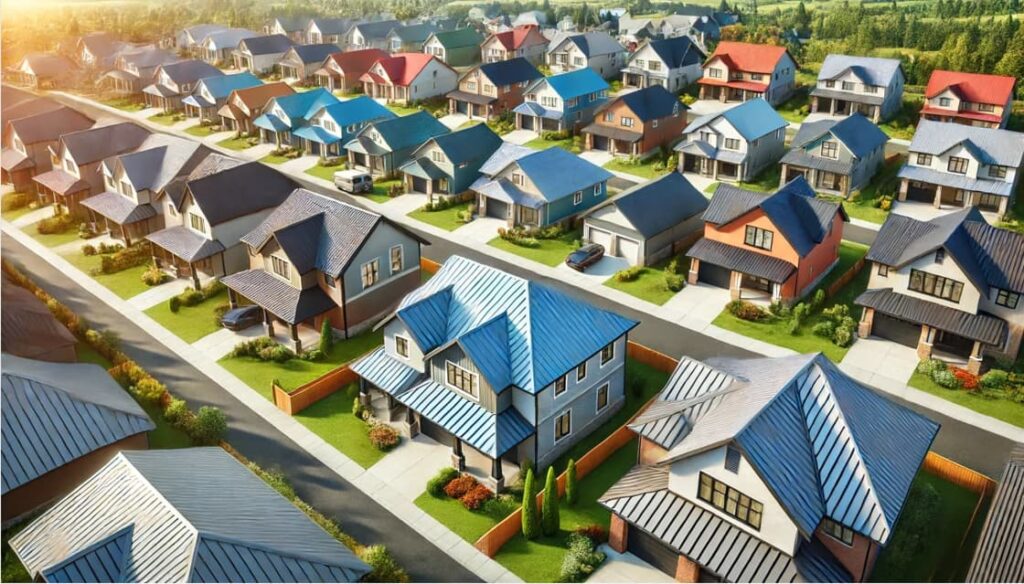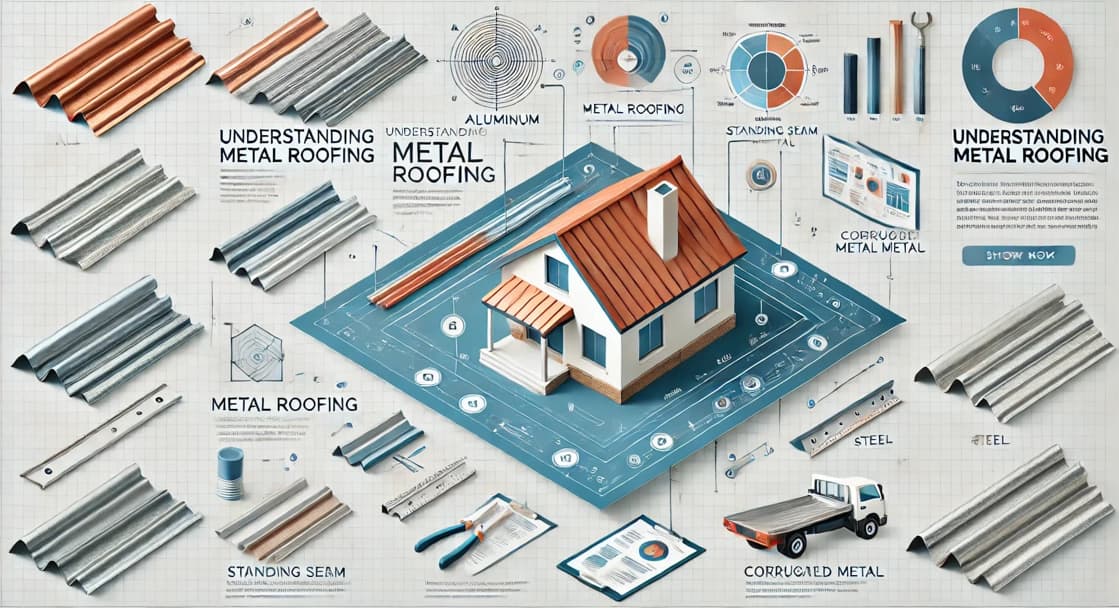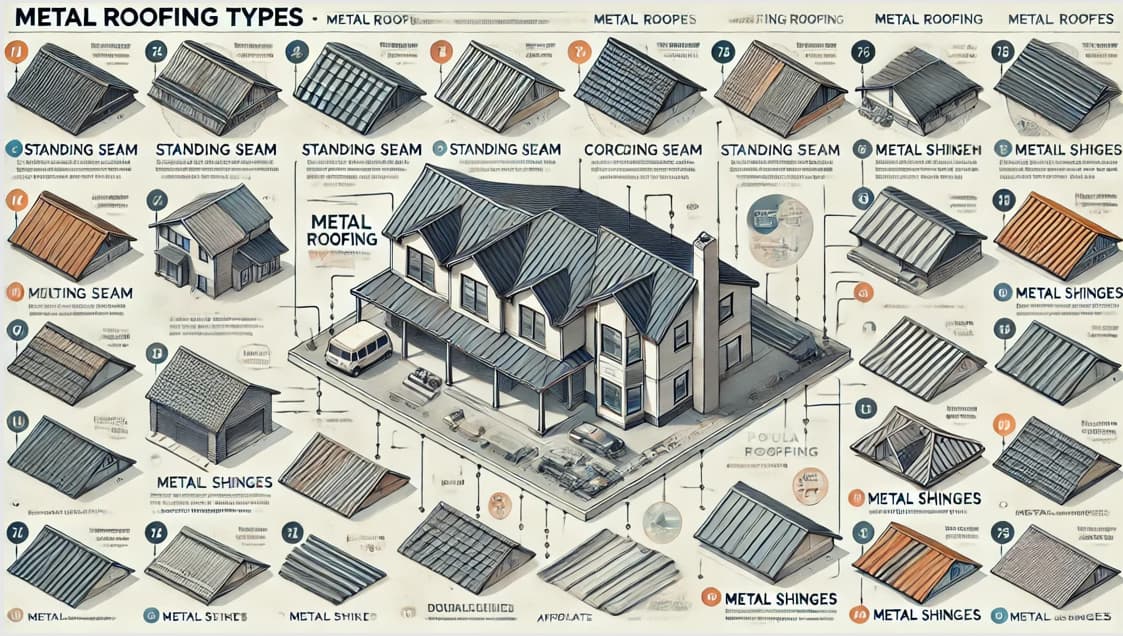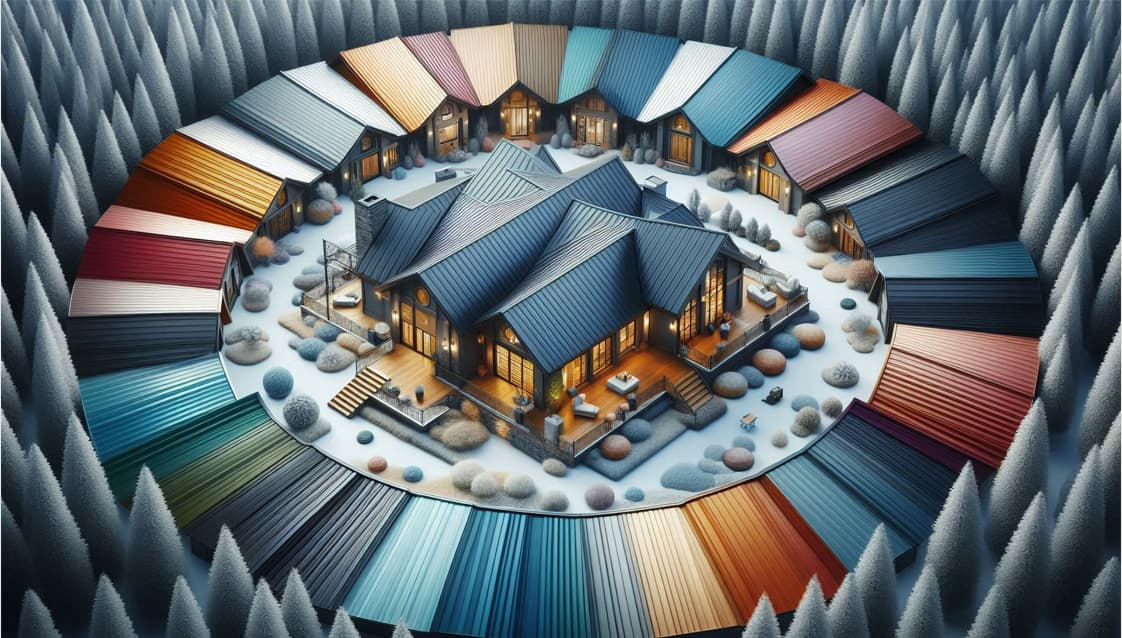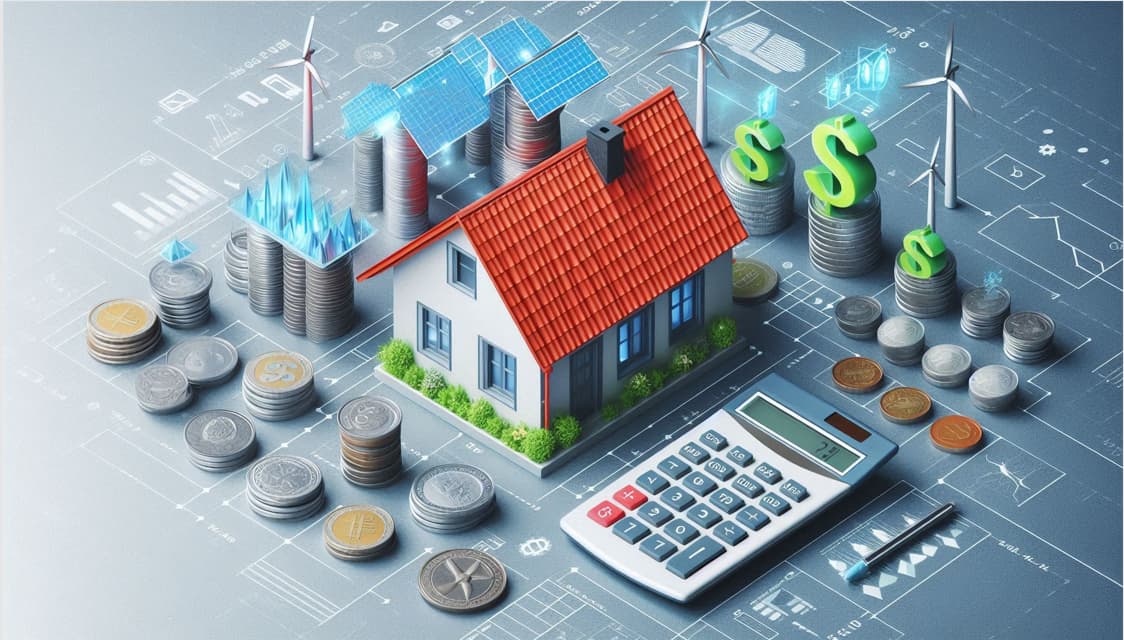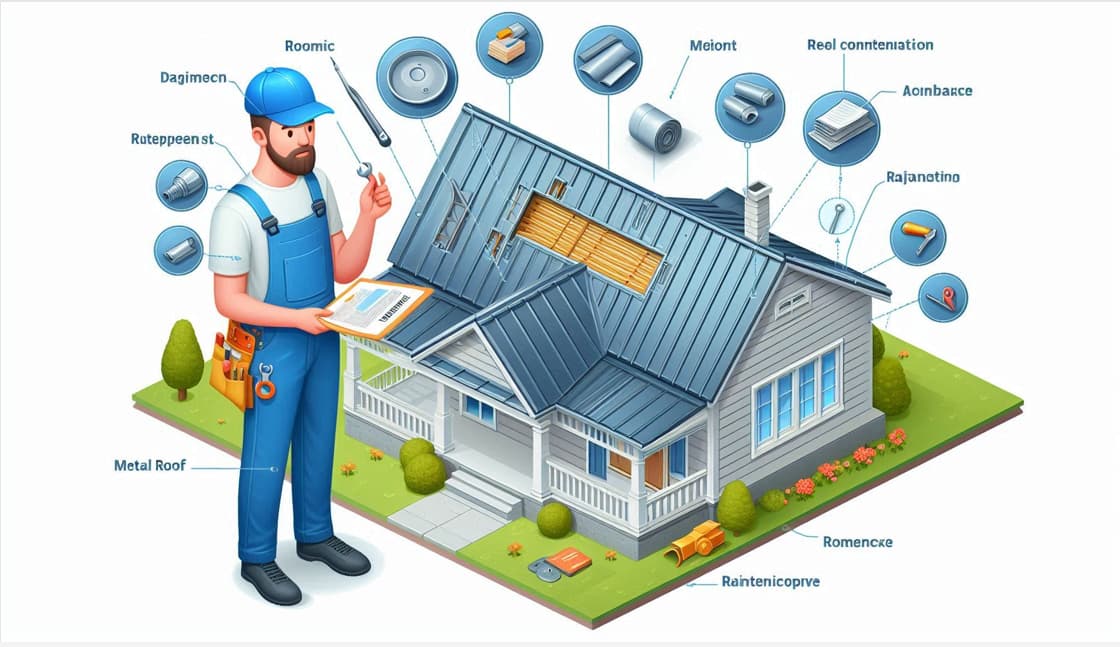Roofing
Metal Roofing Types and Colors: Explore Top Styles & Trends
Metal Roofing Types and Colors? Metal roofing is more than just a practical solution for durability. It’s also an aesthetic enhancement for homes and buildings. This section will explore how metal roofing combines longevity with versatility in style and design.
As we see an increasing trend towards eco-friendly and energy-efficient building materials, metal roofs stand out due to their ability to reflect heat, thereby reducing cooling costs.
Available in a variety of types and a vast array of colors, metal roofing allows for customization to fit any architectural style from traditional homes to contemporary structures.
Moreover, metal roofing is celebrated for its impressive lifespan, often lasting 50 years or more with minimal maintenance.
This section will introduce the reader to the basics of metal roofing, highlighting its practical benefits and the immediate impact of its aesthetic flexibility.
2. Understanding Metal Roofing
Metal roofing is a highly versatile and durable roofing option that offers significant advantages over traditional materials like asphalt shingles, tiles, or cedar shakes.
This section will provide an in-depth exploration of metal roofing, its composition, benefits, and why it stands out as a superior roofing choice for both residential and commercial properties.
Composition of Metal Roofs
Metal roofs are primarily made from steel, aluminum, copper, or zinc alloys—each offering unique qualities:
a. Steel:
The most common material used for metal roofing, it is coated with zinc or a zinc-aluminum mixture to prevent rust.
b. Aluminum:
Lightweight and naturally resistant to corrosion, making it ideal for coastal areas.
c. Copper:
Exceptionally long-lasting and develops a patina over time that can add character to a building.
d. Zinc:
Highly durable and has the ability to self-heal scratches over time, extending its lifespan even further.
These materials are typically formed into sheets, tiles, or shingles, depending on the desired aesthetic and functional requirements of the roofing project.
Benefits of Metal Roofing
Metal roofing offers several compelling advantages that make it a preferred choice for many homeowners and builders:
Durability: Metal roofs can withstand high winds, hail, and severe storms better than most other roofing materials. They are also resistant to fire, mildew, insects, and rot.
Longevity: While traditional roofing materials might last 15-30 years, metal roofing can last 50 years or more with minimal maintenance.
Energy Efficiency: Metal roofs reflect solar radiant heat, which can reduce cooling costs by 10-25%.
Environmentally Friendly: Metal roofs are 100% recyclable at the end of their life. Most contain a significant amount of recycled material, contributing to their sustainability.
Aesthetic Variety: Available in a wide range of colors, finishes, and designs to complement any architectural style.
Installation and Maintenance
Installing metal roofing requires professional expertise to ensure that the panels are properly aligned, fastened, and sealed.
Though the initial cost may be higher than some other roofing materials, the long-term savings in maintenance and energy bills make it a cost-effective option over time.
Metal roofs require little maintenance, typically needing only occasional cleaning to maintain their appearance and functionality.
For those considering a metal roof, our comprehensive guide provides step-by-step instructions on selecting the right materials.
Preparing for installation, and maintaining your roof to maximize its lifespan. Check out our selection of high-quality metal roofing materials and accessories available for purchase.
3: Overview of Popular Metal Roofing Types
This section will provide a comprehensive guide to the most commonly used types of metal roofing, offering readers a clear understanding of each type’s unique benefits and suitable applications.
Standing Seam Metal Roofing:
Known for its clean, vertical lines, standing seam roofing is a popular choice for modern and traditional buildings alike.
It features panels that interlock at the edges, raised above the roof’s flat surface, which protects against water penetration.
Corrugated Metal Roofing:
Ideal for industrial or rural buildings, corrugated metal roofing is characterized by its strength and resilience, thanks to its wavy form which effectively disperses weather elements.
Metal Shingles:
Offering the aesthetic of traditional shingles with the durability of metal, these are often chosen for their traditional look that doesn’t compromise on weather resistance.
Metal Tile Roofing:
These tiles mimic clay or concrete tiles but are much lighter, reducing structural stress and offering longevity and durability typical of metal.
Each type comes with specific installation methods, energy efficiencies, and aesthetic possibilities, making them suitable for different architectural styles and climate conditions.
Explore our extensive catalog of metal roofing types to find the perfect match for your building project, complete with exclusive discounts on your first order.
4. Choosing the Right Color for Metal Roofing
Selecting the right color for your metal roof involves more than matching it with your home’s exterior—it plays a crucial role in energy efficiency and comfort.
The color you choose can significantly affect your home’s internal temperature and, consequently, your energy bills.
Impact of Roof Color on Energy Efficiency
Light Colors:
Lighter shades like whites, light grays, and pastels are known for their reflective properties. They can reflect a substantial amount of sunlight, reducing the amount of heat absorbed by your home.
This can keep indoor temperatures cooler during hot summer months, reducing the reliance on air conditioning.
Dark Colors:
Darker colors, such as black, dark gray, or deep blues, absorb more heat from sunlight, which can be beneficial in colder climates by helping to warm the house during winter months.
However, in warmer climates, these colors can increase cooling costs.
Aesthetic Considerations
Choosing a color also involves considering the architectural style of your home and the landscape around it. Here are some tips:
Traditional Homes:
Classic colors like blacks, grays, and earth tones often work well.
Modern Homes:
Bold colors or contrasting combinations can complement the sleek lines of contemporary architecture.
Rural or Wooded Settings:
Greens or browns can harmonize with the natural surroundings.
Explore our range of metal roof color samples. Find the perfect match for your home and benefit from our expert guidance on choosing energy-efficient colors.
5. Trending Metal Roof Colors for 2024
As homeowners look to both personalize and add value to their homes, the choice of metal roof color has expanded beyond the traditional.
Here’s a look at the trending metal roof colors for 2024 that blend both style and functionality.
Popular Color Trends
Classic Neutral Tones:
These remain popular for their versatility and timelessness. Colors like charcoal gray and matte black are on-trend for adding sophistication to any home style.
Vibrant Colors:
Bold colors like bright blues, reds, and even some emerging trends in vibrant greens are becoming popular for homeowners wanting to make a statement.
Metallic and Natural Finishes:
Copper, bronze, and metallic finishes are seeing a resurgence, especially in luxury homes, for their ability to add a distinctive touch that ages beautifully.
Cool Roof Colors:
Colors like white and light beige are increasingly popular for their energy-efficient properties, reflecting more sunlight and reducing cooling costs.
Check out our latest blog post featuring a gallery of homes with these trending colors and find links to our top-rated color options for 2024. Shop now and transform the look and efficiency of your home with our top picks for metal roof colors.
6. Advantages of Metal Roofing
Metal roofing is not only durable but also provides several advantages that make it an excellent choice for homeowners looking for a long-term solution.
Longevity and Durability
Long Life Span:
Metal roofs can last over 50 years, significantly outperforming traditional materials like asphalt shingles.
Weather Resistance:
They withstand severe weather conditions, including heavy snow, hail, and high winds, without corroding or cracking.
Environmental and Energy Efficiency
Eco-Friendly:
Most metal roofing materials are made from recycled content and are 100% recyclable at the end of their life.
Energy Savings:
Metal roofs are often coated with reflective pigments that reflect solar energy, thereby reducing cooling costs by up to 25%.
Discover our selection of energy-efficient metal roofs with advanced reflective technology to reduce your energy bills. Shop now and invest in sustainability!
7. Installation Process
The correct installation of a metal roof is critical for its performance and longevity. Here’s what the installation process generally involves:
Steps in Metal Roof Installation
Preparation: Removal of the old roof (if necessary) and preparation of the roof deck.
Installation of Underlayment: This water-resistant layer protects against moisture.
Securing Metal Panels: Panels are fastened to the roof deck, often with hidden fasteners to enhance aesthetics and reduce leak risks.
Sealing and Finishing: Edges and seams are sealed, and finishing elements like ridge caps are added.
Importance of Professional Installation
Expertise: Professional installers ensure that the roof is installed correctly and according to manufacturer specifications.
Warranty: Improper installation can void warranty claims. Professionals provide warranty protection for both materials and labor.
Need professional installation? Click here to schedule a consultation with our certified metal roofing experts.
8. Cost Comparison and Economic Value
While the initial expense may be higher, the long-term economic value of metal roofing cannot be overstated.
Cost-Effectiveness
Upfront Cost: Generally higher than materials like asphalt but competitive with high-end materials like tile or cedar.
Maintenance Savings: Metal roofs require little to no maintenance, unlike other roofing materials that need periodic replacement and repair.
Energy Efficiency: The reflective properties of metal roofs can significantly lower air conditioning costs, especially in warmer climates.
Return on Investment
Home Value: Increases home resale value due to its durability, aesthetic appeal, and energy efficiency.
Insurance Discounts: Some insurers offer discounts on home insurance premiums due to metal roofs’ superior weather resistance.
Check out our cost-benefit analysis tool to see how much you can save with a metal roof over time. Explore financing options to make your investment more affordable.
By understanding these aspects, homeowners can make informed decisions about whether metal roofing is the right choice for their homes, balancing initial costs against long-term benefits and savings.
9. Maintenance Tips for Metal Roofing
Maintaining a metal roof is relatively simple compared to other roofing materials, but regular maintenance can extend its life and enhance its performance.
Here are some key maintenance tips to ensure your metal roof stays in top condition:
a. Regular Inspections
i. Schedule Bi-Annual Inspections: Check your roof in the spring and fall for any signs of damage or wear.
ii. Look for Sealant Failures: Inspect seams, edges, and fasteners for failing sealant that might allow water infiltration.
b. Clean the Roof Surface
i. Remove Debris: Clear leaves, branches, and other debris that can accumulate and retain moisture against the roof.
ii. Wash Off Dirt and Grime: Use a garden hose, soft-bristled brush, and a gentle, non-abrasive cleaner to clean the roof surface. Avoid power washing, as it can damage the paint finish.
c. Prevent and Remove Rust
i. Check for Rust Spots: Especially important for steel roofs, look for any signs of rust and address them immediately.
ii. Use a Rust-Inhibiting Primer: If rust spots do appear, clean the area and apply a rust-inhibiting primer and touch-up paint to prevent spreading.
d. Trim Overhanging Tree Branches
i. Reduce Debris and Dampness: Trim branches that hang over your roof to reduce debris and prevent scratches from branches rubbing against the roof during high winds.
ii. Prevent Moss and Algae Growth: Limiting shade on the roof by trimming branches can also prevent the growth of moss and algae.
e. Ensure Proper Drainage
i. Keep Gutters Clean: Ensure that gutters and downspouts are free from debris to prevent water from standing on the roof.
ii. Inspect for Ponding: After heavy rain, check for areas of standing water which can indicate a problem with the roof structure or drainage system.
f. Repair Damage Promptly
i. Fix Minor Issues Quickly: Address small problems like loose screws or minor leaks before they turn into bigger issues.
ii. Consult Professionals for Major Repairs: For significant damage or issues, it’s best to consult a professional roofing contractor who specializes in metal roofs.
Looking for professional roofing maintenance? Our partners offer comprehensive maintenance packages that ensure your metal roof remains in pristine condition. Click here to learn more and schedule your maintenance check-up.
Conclusion:
Deciding on a metal roof involves weighing its long-term benefits against the initial investment.
Metal roofing, renowned for its durability, longevity, and energy efficiency, represents a smart choice for homeowners looking for a roof that lasts over half a century and offers considerable energy savings due to its reflective properties.
The array of available colors and styles means there’s likely a metal roofing option that not only meets your functional needs but also complements your home’s aesthetic.
Whether you prefer the sleek lines of a standing seam roof or the traditional appearance of metal shingles, you can find a solution that enhances your home’s curb appeal and increases its resale value.
Furthermore, the eco-friendly nature of metal roofing—often made from recycled materials and entirely recyclable at the end of its life makes it an excellent choice for environmentally conscious homeowners.
Investing in metal roofing is investing in the future of your home. It not only shields your home from the elements but also reduces cooling costs, minimizes maintenance efforts, and contributes to a greener planet.
Have you considered how a metal roof could transform your home’s efficiency and style?
Interested in seeing how a new metal roof would look on your home? Contact us today for a consultation and see what options best suit your style and needs.
Recent Posts
- Residential Metal Roofing Types: Explore Top Choices
- Commercial Metal Roofing Types: A Comprehensive Guide
- Metal Roofing Types: Choose Durability and Style
- Standing Seam Metal Roofing: Unleash Modern Durability

